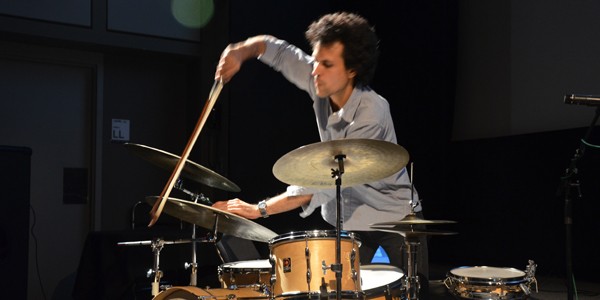Today’s guest post is by CAST Postdoctoral Fellow David Mather. Mather’s research on early Italian futurism is an interdisciplinary project investigating the visual structure of movement across the mediums of painting, cinema, sculpture, and photography. He is currently at work on the CAST symposium to be held September 26 to 28, 2014, “Seeing/Sounding/Sensing.”
For the inaugural concert in the new collaborative series between the List Visual Arts Center and WMBR, called Ampersand, about 100 people were treated to an exceptional evening of solo-performances. Luke Damrosch opened with an incredible 45-minute, solo drum performance that signaled to me one of the most exciting directions in years for experimental music. The mild-mannered Damrosch took his seat at a standard drum kit and took a few minutes (and one false start) to coordinate a video track projected onto a large screen behind and above him with the start of a pre-recorded rhythmic track of his own electroacoustic design running on a nearby laptop. Once properly synched, he launched into a sequence of astounding rhythmic possibilities—following multiple directions at once, rising and falling over huge swathes of musical terrain, while seeming to confront and then tame a series of absurdly complex time signatures.
This epic, mind-altering composition was sufficiently textured and fascinating on its own without the immersive video, which combined telephony and sound propagation didactics with what seemed like home-made travel footage. I later discovered material on Damrosch’s website related to this experimental compositional method seemingly of his own invention, in which apparently each limb of the performer iterates a separate complex pattern. Distributed across four interlocking, but distinct parts–i.e., each limb of the performer’s body–the resulting impression brings a dare-devilish quality of accelerating danger to the more clear-headed and precise work of mapping out what seemed to be an otherworldly mode of communication.
After an intermission, Julia Kent played on an electric cello a series of her own separate compositions, each ranging from 4 to 8 minutes. Her layered, often laconic works derived from real-time signal processing of her instrument, again by laptop, which modulated and also repeated discrete musical phrases and melded them with synthesized, recorded tracks. The additive effect of multiple musical passages created a dense polyphonic fabric that proceeded through variations in the intensity in the phrases or morphed lyrically into different melodies. Added to the mesmerizing mood of the music was video accompaniment of white smoke drifting in real-time across the black background. To my ears, the most interesting work was an apocalyptic composition that pointed to what seemed to be an affiliation with death metal or death rock perhaps. It made use of a rhythmic quality that suggested a driving ambition or some type of narrative intensification. Suddenly something felt like it was at stake when the generally cinematic quality of her lilting, layered melodies came into contact with this more structured, rhythmic patterning.
This initial success makes it all-the-more-interesting to find out what will come next in an exciting new concert series that continues throughout the fall.
The Ampersand Concert series is a joint programming initiative between the MIT List Visual Arts Center and MIT’s radio station WMBR. Curated by Yurij Roman Lojko and Elliot Avila, the List and WMBR will present a monthly concert series of eclectic and diverse independent music with an emphasis on the unique relationships that can exist between visual art and innovative music.

